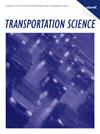Humanitarian Relief Distribution Problem: An Adjustable Robust Optimization Approach
IF 4.4
2区 工程技术
Q1 OPERATIONS RESEARCH & MANAGEMENT SCIENCE
引用次数: 3
Abstract
Management of humanitarian logistics operations is one of the most critical planning problems to be addressed immediately after a disaster. The response phase covers the first 12 hours after the disaster and is prone to uncertainties because of debris and gridlock traffic influencing the dispatching operations of relief logistics teams in the areas affected. Moreover, the teams have limited time and resources, and they must provide equitable distribution of supplies to affected people. This paper proposes an adjustable robust optimization approach for the associated humanitarian logistics problem. The approach creates routes for relief logistics teams and decides the service times of the visited sites to distribute relief supplies by taking the uncertainty in travel times into account. The associated model allows relief logistics teams to adjust their service decisions according to the revealed information during the process. Hence, our solutions are robust for the worst-case realization of travel times, but still more flexible and less conservative than those of static robust optimization. We propose novel reformulation techniques to model these adjustable decisions. The resulting models are computationally challenging optimization problems to be solved by exact methods, and, hence, we propose heuristic algorithms. The state-of-the-art heuristic, which is based on clustering and a dedicated decision-rule algorithm, yields near-optimal results for medium-sized instances and is scalable even for large-sized instances. We have also shown the effectiveness of our approach in a case study using a data set obtained from an earthquake that hit the Van province of Turkey in 2011. Supplemental Material: The online appendix is available at https://doi.org/10.1287/trsc.2023.1204 .人道主义救援分配问题:一种可调鲁棒优化方法
人道主义后勤行动的管理是灾后需要立即解决的最关键的规划问题之一。应急阶段涵盖灾难发生后的前12个小时,由于碎片和交通堵塞影响了救灾后勤队在受灾地区的调度行动,因此很容易出现不确定性。此外,这些小组的时间和资源有限,他们必须向受影响的人公平分配物资。针对相关的人道主义物流问题,本文提出了一种可调整的鲁棒优化方法。该方法为救援后勤小组确定路线,并考虑到旅行时间的不确定性,决定被访问地点分发救援物资的服务时间。相关模型允许救援后勤团队根据过程中披露的信息调整其服务决策。因此,我们的解决方案对于旅行时间的最坏情况实现是稳健的,但仍然比静态稳健优化的解决方案更灵活,也不那么保守。我们提出了新的重新表述技术来对这些可调整的决策进行建模。由此产生的模型是计算上具有挑战性的优化问题,需要通过精确的方法来解决,因此,我们提出了启发式算法。最先进的启发式算法基于聚类和专用决策规则算法,对于中型实例产生接近最优的结果,即使对于大型实例也是可扩展的。我们还在一个案例研究中展示了我们的方法的有效性,该研究使用了2011年土耳其凡省地震的数据集。补充材料:在线附录可在https://doi.org/10.1287/trsc.2023.1204。
本文章由计算机程序翻译,如有差异,请以英文原文为准。
求助全文
约1分钟内获得全文
求助全文
来源期刊

Transportation Science
工程技术-运筹学与管理科学
CiteScore
8.30
自引率
10.90%
发文量
111
审稿时长
12 months
期刊介绍:
Transportation Science, published quarterly by INFORMS, is the flagship journal of the Transportation Science and Logistics Society of INFORMS. As the foremost scientific journal in the cross-disciplinary operational research field of transportation analysis, Transportation Science publishes high-quality original contributions and surveys on phenomena associated with all modes of transportation, present and prospective, including mainly all levels of planning, design, economic, operational, and social aspects. Transportation Science focuses primarily on fundamental theories, coupled with observational and experimental studies of transportation and logistics phenomena and processes, mathematical models, advanced methodologies and novel applications in transportation and logistics systems analysis, planning and design. The journal covers a broad range of topics that include vehicular and human traffic flow theories, models and their application to traffic operations and management, strategic, tactical, and operational planning of transportation and logistics systems; performance analysis methods and system design and optimization; theories and analysis methods for network and spatial activity interaction, equilibrium and dynamics; economics of transportation system supply and evaluation; methodologies for analysis of transportation user behavior and the demand for transportation and logistics services.
Transportation Science is international in scope, with editors from nations around the globe. The editorial board reflects the diverse interdisciplinary interests of the transportation science and logistics community, with members that hold primary affiliations in engineering (civil, industrial, and aeronautical), physics, economics, applied mathematics, and business.
 求助内容:
求助内容: 应助结果提醒方式:
应助结果提醒方式:


